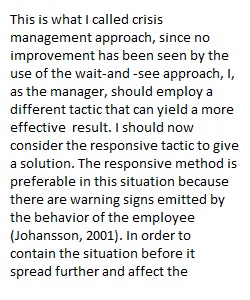


Q In the department you manage is an employee whose performance and behavior have undergone considerable change in a few weeks time. Before change became noticeable, she was steady and reliable for nearly three years. Although she was not a stellar performer, her work has always acceptable. The employee is well liked in the department. In the last eight to ten weeks, she has been absent and tardy more times than in previous three years of employment. She has recently made several serious errors. Consequently, you are concerned about the potential effects on the quality of the department's output. During the past two weeks, you have taken a wait-and-see approach, hoping that her problem, whatever it may be, would go away. However, no improvement has been forthcoming and you feel you need to do something. Describe the approach you should consider when approaching this individual and trying to resolve her apparent problems. Instructions Join the weekly discussion by making your initial post by 11:55 p.m. Eastern Time on Wednesday. Your answer should state your point of view on the question, supported by the required readings and your experience. Further, review the postings of your classmates and respond thoughtfully to at least two of them by11:55 p.m. Eastern Time on Sunday. Compose each response of at least two paragraphs to demonstrate both that you understand your classmate's position, and also that you can apply the reading material appropriately.
View Related Questions